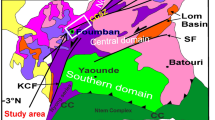Abstract
The Jinwozi gold deposit consists of gold-bearing quartz veins in a biotite granodiorite of Hercynian age (zircon U-Pb age ≈ 335.7 Ma). Ore mineralogy is simple. In addition to native gold, there are only small amounts of sulfides, mainly pyrite and minor sphalerite, chalcopyrite and galena. δ34S values average 6.69‰, and δ18O 13.99‰ Abundant CO2 is contained in fluid inclusions from quartz. Homogenization temperatures of fluid inclusions are between 186 and 262 °C. REE distribution patterns indicate that the igneous mass may have been derived from a common initial material of calcareous-argillaceous sediments and alkali basalts as the country rocks. In other words, the Jinwozi granodiorite is of remelting origin from crustal material. Isotopic evidence of S, O and Pb shows that the ore-forming material is genetically related to magmatic hydrothermal activity.
Similar content being viewed by others
Author information
Authors and Affiliations
Rights and permissions
About this article
Cite this article
Zhengen, Z., Nansheng, C. Geochemical characteristics of Jinwozi gold deposit, Xinjiang. Chin. J. of Geochem. 10, 99–108 (1991). https://doi.org/10.1007/BF02837710
Issue Date:
DOI: https://doi.org/10.1007/BF02837710




